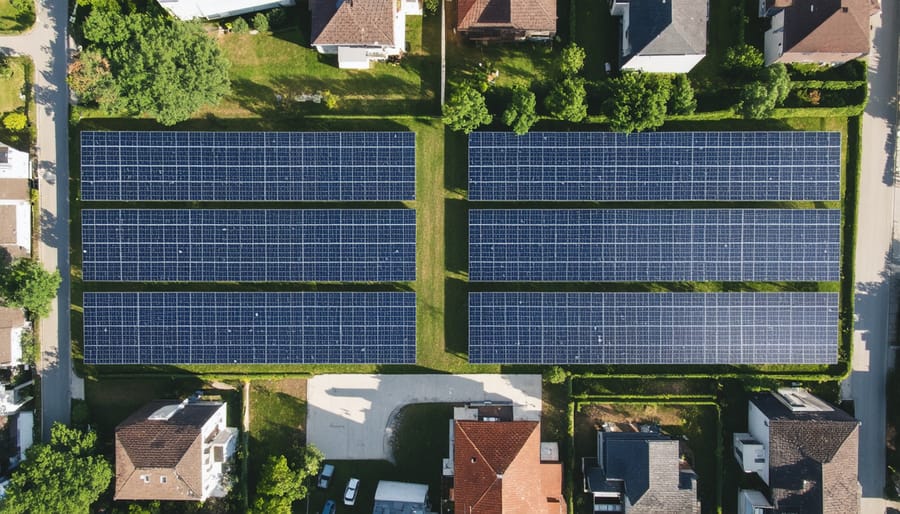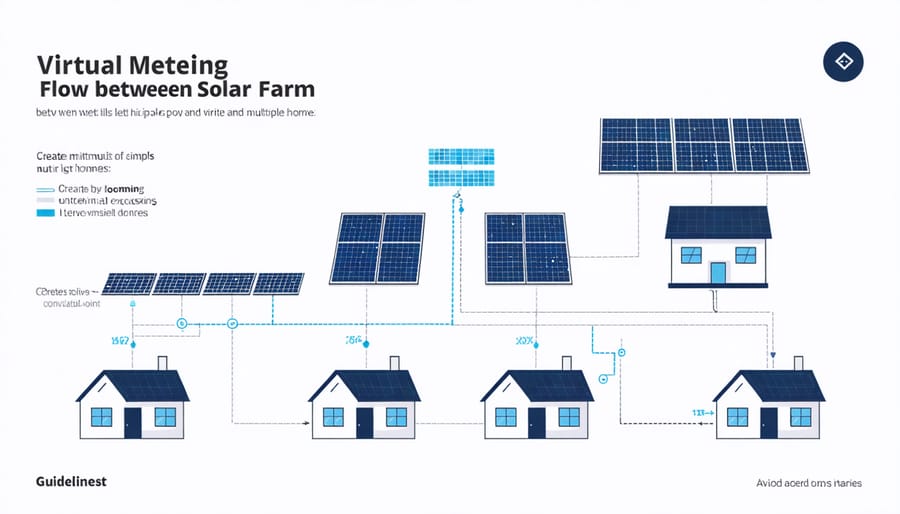Community Solar Made Simple: How Your Neighborhood Can Power Its Future

Community solar transforms how neighborhoods access renewable energy, enabling multiple households to share the benefits of a single solar installation without installing panels on their own roofs. This innovative approach drives Europe’s sustainable energy transition while making clean power accessible to everyone—from apartment dwellers to small businesses.
Unlike traditional solar installations, community solar projects operate through a subscription model where participants purchase shares of the system’s output, receiving credits on their electricity bills proportional to their investment. This democratized approach removes common barriers like high upfront costs, unsuitable roof conditions, or rental property restrictions that typically prevent individuals from adopting solar energy.
The concept revolutionizes renewable energy accessibility by creating economies of scale, reducing individual risk, and fostering community engagement in clean energy development. As European communities increasingly seek sustainable solutions, these shared solar installations emerge as a practical pathway to collective energy independence and reduced carbon emissions.
What Makes Community Solar Different?

Shared Solar Infrastructure
Community solar installations operate on a shared infrastructure model, where a single large-scale solar array serves multiple households or businesses. These installations typically feature advanced solar technology designed to maximize energy generation and distribution efficiency. The solar panels are strategically positioned in an optimal location, often on open land or large rooftops, where they can capture maximum sunlight throughout the day.
Participants in the community solar project receive a designated portion of the total energy production, proportional to their investment or subscription level. This shared approach eliminates the need for individual rooftop installations while delivering comparable benefits. The energy generated flows into the local power grid, and subscribers receive credits on their electricity bills based on their share of the project’s output.
The infrastructure typically includes smart metering systems, sophisticated monitoring equipment, and grid connection hardware that ensures seamless energy distribution. Regular maintenance and performance optimization are handled by professional operators, relieving individual participants of technical responsibilities while ensuring optimal system performance year-round.
Virtual Net Metering
Virtual net metering forms the backbone of community solar billing systems, enabling fair distribution of solar energy credits among participants. Through this innovative mechanism, the electricity generated by the community solar installation is precisely monitored and allocated to subscribers based on their agreed-upon share of the project.
When the solar array produces electricity, the utility company measures the total generation and converts it into credits. These credits are then distributed proportionally among participants according to their subscription size. For instance, if a participant subscribes to 10% of the project’s capacity, they receive 10% of the generated credits on their monthly utility bill.
The utility company applies these credits directly to participants’ electricity bills, reducing their monthly charges. This system operates seamlessly within existing billing infrastructure, making it convenient for both subscribers and utility providers. Importantly, participants can benefit from solar energy production without installing panels on their own properties, while maintaining accurate tracking of their energy savings through detailed monthly statements.
Subscribers can easily monitor their credit allocation and energy consumption through online portals, ensuring transparency and enabling informed energy management decisions.

The Community Solar Process
Project Planning and Site Selection
The success of a community solar project hinges on thorough planning and strategic site selection. Initially, project developers conduct comprehensive feasibility studies to assess various locations, considering factors like solar radiation levels, grid connectivity, and local regulations. These studies are crucial for determining project viability and securing solar project funding.
Ideal sites typically feature unobstructed southern exposure, minimal shading from buildings or vegetation, and proximity to existing electrical infrastructure. In Europe, many successful projects utilize previously developed areas like industrial rooftops, abandoned agricultural land, or brownfield sites, aligning with sustainable land use practices.
Technical assessments evaluate soil conditions, drainage patterns, and structural requirements for solar panel installations. Environmental impact studies ensure compliance with EU environmental regulations and identify measures to protect local biodiversity. Local community engagement during this phase is essential, as it builds support and helps address concerns early in the development process.
The planning phase also includes detailed energy yield predictions, incorporating factors like seasonal variations and weather patterns specific to the region. These calculations help determine the optimal system size and configuration, ensuring the project can meet the community’s energy needs while maintaining economic viability.
Developers must also secure necessary permits and grid connection agreements, which vary across different European jurisdictions. Early consultation with local authorities and utility providers streamlines this process and prevents potential delays.

Participant Enrollment
Joining a community solar project is straightforward and accessible to most European residents and businesses. Participants typically begin by checking their eligibility based on their location within the project’s service area. Most programmes welcome both property owners and renters, making solar energy accessible to a broader community demographic.
The enrollment process usually starts with reviewing available subscription options. Participants can choose their preferred level of involvement, often based on their average energy consumption or desired investment level. Many projects offer flexible subscription sizes, ranging from a few panels to larger portions of the solar installation.
Upon enrollment, participants sign a solar subscription agreement that outlines the terms, duration, and expected benefits. These agreements typically run for 12-24 months, with options for renewal. The document details important aspects such as monthly fees, estimated energy credits, and the procedure for transferring or cancelling participation.
Subscribers can expect to receive monthly credits on their electricity bills based on their share of the solar project’s generation. Most programmes provide online portals where participants can track their portion’s performance, view energy production data, and access their account information.
The enrollment process often includes comprehensive support from project coordinators who guide new participants through documentation, answer questions, and ensure a smooth transition into the community solar programme. Many projects also offer educational resources and regular updates about the installation’s performance and environmental impact.
Energy Distribution and Management
Community solar installations rely on sophisticated energy distribution and management systems to ensure efficient power delivery to all participants. The generated solar electricity flows into the local power grid through specialized inverters and transformers, which convert the DC power from solar panels into grid-compatible AC power.
Smart meters and advanced monitoring systems track energy production and consumption in real-time, allowing for precise allocation of solar credits to each participant’s account. This technology enables transparent energy accounting, where subscribers can monitor their share of solar production and corresponding savings through user-friendly online portals or mobile applications.
The distribution network incorporates advanced power management solutions that help balance supply and demand, ensuring grid stability. During peak production hours, when solar generation exceeds immediate community needs, excess energy can be stored in grid-scale batteries or fed back into the broader power network. This flexibility helps maximize the system’s efficiency and environmental benefits.
Modern energy management platforms also facilitate automated billing and credit distribution, simplifying the administrative aspects of community solar participation. These systems can adjust to varying consumption patterns and accommodate changes in subscription levels, making the program adaptable to community needs.
To ensure reliable service, community solar installations include sophisticated fault detection and performance monitoring systems. These tools help operators identify and address potential issues before they impact energy distribution, maintaining consistent power delivery to all participants.
Benefits for European Communities
Economic Advantages
Community solar projects offer substantial financial advantages for participants across Europe. The most immediate benefit is the reduction in electricity costs, with participants typically saving 10-20% on their monthly energy bills. This cost advantage stems from the economies of scale achieved through shared infrastructure and maintenance costs.
By joining a community solar initiative, participants can access the benefits of solar energy without the significant upfront investment required for individual rooftop installations. The shared ownership model distributes costs among multiple stakeholders, making solar energy accessible to those who might otherwise find it financially prohibitive.
Subscribers benefit from predictable energy costs, as community solar rates are often locked in for extended periods, providing protection against rising utility prices. Additionally, many European countries offer attractive feed-in tariffs and incentives for community solar participants, enhancing the financial returns.
The economic advantages extend beyond direct energy savings. Property values often increase in areas with community solar access, and local economies benefit from job creation during installation and ongoing maintenance. For businesses, participation can lead to improved corporate social responsibility profiles and potential tax benefits.
Moreover, the flexible subscription models allow participants to adjust their involvement based on their energy needs and financial capabilities, ensuring that the economic benefits remain aligned with individual circumstances.
Environmental Impact
Community solar projects deliver substantial environmental benefits by reducing carbon emissions and promoting sustainable energy generation. A typical community solar installation of 1 MW can offset approximately 1,500 tonnes of CO2 emissions annually, equivalent to removing 326 cars from the road or planting 25,000 trees.
These projects contribute significantly to Europe’s renewable energy targets while minimising land impact through strategic placement on brownfield sites, industrial rooftops, and previously developed areas. By centralising solar production in optimal locations, community solar achieves higher energy efficiency compared to individual rooftop installations.
The environmental advantages extend beyond carbon reduction. Community solar farms often incorporate biodiversity measures, creating wildlife corridors and supporting local ecosystems. Many projects include native plant species, bee-friendly vegetation, and natural habitats beneath and around the panels, transforming industrial spaces into thriving ecological zones.
Furthermore, community solar reduces the need for individual equipment manufacturing and installation, decreasing the overall environmental footprint of solar adoption. The shared infrastructure model optimises resource use and minimises waste, while professional maintenance ensures maximum system efficiency throughout the installation’s lifetime.
As European communities transition towards sustainable energy solutions, community solar projects serve as powerful tools for achieving climate action goals while fostering environmental stewardship at the local level.
Getting Started with Community Solar
Getting involved in community solar projects is more straightforward than many people imagine, especially with Europe’s supportive current solar policy frameworks. The first step is gathering interested community members and conducting an initial feasibility assessment. This typically involves evaluating available roof spaces, land areas, or other suitable locations for solar panel installation.
Start by forming a steering committee of dedicated individuals who can drive the project forward. This group should include people with diverse skills – from technical knowledge to project management and community engagement expertise. Local energy cooperatives and municipal authorities can provide valuable guidance and support during this phase.
Next, assess the financial aspects. Community solar projects in Europe often benefit from various funding mechanisms, including government grants, cooperative financing models, and crowd-funding options. Consider engaging professional solar consultants to develop detailed cost projections and return-on-investment analyses.
Technical planning is crucial. Work with certified solar installers to determine the optimal system size, equipment specifications, and grid connection requirements. They can help navigate local building regulations and secure necessary permits. Many European municipalities have streamlined these processes to encourage community renewable energy initiatives.
Community engagement plays a vital role in project success. Organize information sessions to explain the benefits, costs, and participation options to potential members. Be transparent about both opportunities and challenges. Consider establishing a legal entity, such as a cooperative or association, to manage the project and ensure fair distribution of benefits.
Implementation typically takes 6-12 months, depending on project scale and complexity. During this time, maintain regular communication with stakeholders, monitor progress against milestones, and address concerns promptly. Many successful community solar projects in Europe have demonstrated that careful planning and strong community involvement are key to long-term sustainability.
Community solar represents a powerful solution for Europe’s sustainable energy future, offering an innovative approach to renewable energy adoption that benefits both individuals and communities. Throughout this guide, we’ve explored how these projects make solar energy accessible to everyone, regardless of their living situation or financial capabilities.
By participating in community solar initiatives, you’re not just investing in clean energy; you’re joining a growing movement that strengthens local economies, reduces carbon emissions, and builds more resilient communities. The flexible subscription models, shared maintenance responsibilities, and distributed benefits make it an attractive option for homeowners, businesses, and municipalities alike.
Remember that community solar projects in Europe are supported by various EU and national-level incentives, making participation more affordable than ever. Whether you’re interested in joining an existing project or initiating one in your community, the infrastructure and support systems are in place to help you succeed.
As Europe continues its transition toward renewable energy, community solar projects will play an increasingly vital role in achieving our collective sustainability goals. We encourage you to explore community solar opportunities in your area, connect with local energy cooperatives, and take an active role in shaping a cleaner, more sustainable energy future for all.
Take the first step today by contacting your local energy authority or joining existing community solar initiatives. Together, we can build a more sustainable and energy-independent Europe.
Leave a Reply